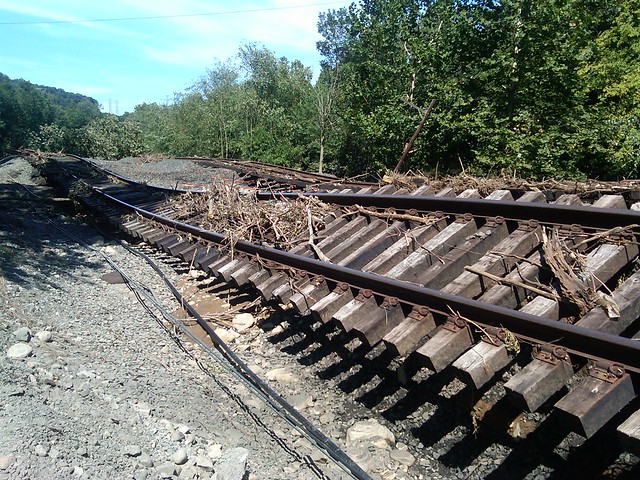
The Port Jervis line will be out of service for months following Hurricane Irene. (Photo courtesy of Metropolitan Transportation Authority, Hilary Ring)
Metro-North’s Port Jervis line is in trouble. As the pictures have shown us this week, the west-of-the-Hudson commuter rail line was hit hard by Hurricane Irene. It’s currently out of service and will be for months, according to MTA CEO and Chairman Jay Walder. By all accounts, this is the worst weather-related transportation outage the region has suffered in decades.
Earlier this week, the MTA had to pull out its emergency powers to begin to ready the Port Jervis line for revenue service again. “The damage suffered by the Port Jervis Line can only be described as catastrophic,” Walder said during a tour of the destruction. “There are sections of track literally suspended in the air, and in many places we will have to build a new railroad from scratch, from the foundation to the tracks to the signals. I have directed Metro-North to take such steps as are necessary to expeditiously and fully address the catastrophic damage suffered along the Port Jervis Line as a result of Irene. Rebuilding this infrastructure is going to be a long and difficult process, but we are taking every action in our power to continue serving our customers, to reduce unnecessary delay and to communicate every step of the way.”
The worst of the damage is extensive. Near Sloatsburg, three sections of track totaling 1000 feet each are gone. A smaller section washed out to a depth of eight feet. Several bridges have sustained damage, and the signal system which is exposed and under water will have to be rebuilt. By using the emergency powers, the MTA can bypass lengthy procurement processes and can push through these badly needed repairs faster. “The Port Jervis Line is critical to the MTA’s West of Hudson customers, so it’s important that we use emergency powers to remove red tape and rebuild this infrastructure as quickly as possible,” MTA Board Member Susan Metzger said.
In The Times today, Christine Haughney writes about the trip to Orange and Rockland Counties, and the report from the devastation really brings it home. Walder, who said the time for repairs would be “measured in months,” seemed floored by the damage. “In nearly 30 years, I’ve never seen anything like that,” he said.
But beyond the emotional impact of the storm’s path, the MTA has to ask a lot of questions about the Port Jervis line’s future. It has been a long slow ride toward modernity for this 100-year-old rail branch, and while ridership is still low — barely 2300 per weekday and under 800 per weekend — it provides a vital lifeline to the city for a rapidly-growing part of New York State. For now, the authority will bus the commuters from Harriman to New Jersey Transit’s Ramsey/Route 17 station. In the coming months, the MTA will try to expand bus offerings.
Meanwhile, the economics of the situation are a cause for concern as well. As we know, the MTA has had to cut back its five-year capital plan, and for now, it will have to dip into cash reserves to fund this emergency repair work. The authority hopes that FEMA dollars will flow its way and that insurance proceeds can pick up some slack, but it also can’t afford to wait for the money to flow through the red tape. For now, the emergency powers will allow the MTA to get started on this project.
So now the MTA has an opportunity to recreate an old rail line or jettison something that many consider to be a drag on the MTA’s bottom line and a sprawl-promoting spur. They can improve the signals on the Port Jervis line. They can double-track some of the line. Or they could work quickly and do nothing much new but just work to get service running again. Taking the long view would pay off in the end, but transit authorities haven’t taken the long view too frequently these days. Now we’ll see what happens with the closest thing to a blank slate the region has.

